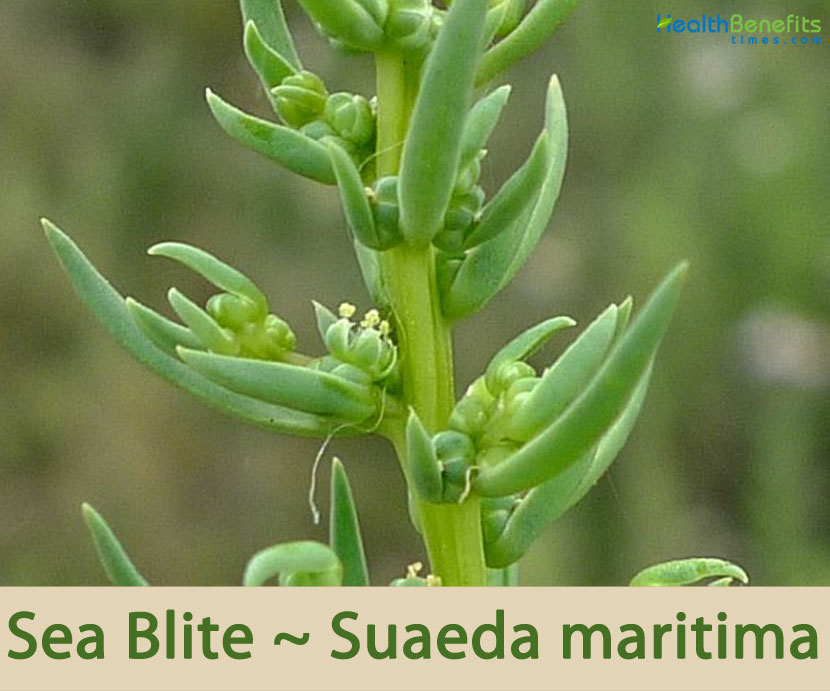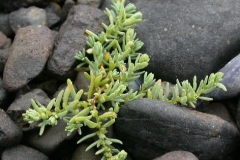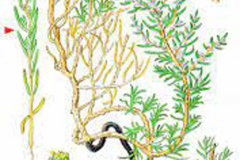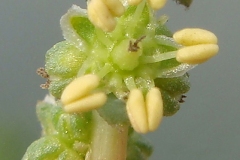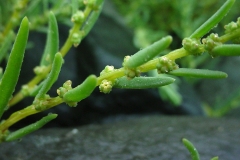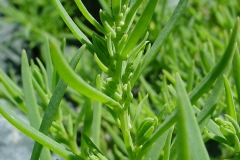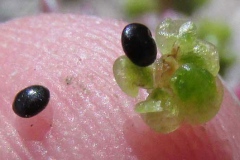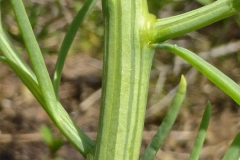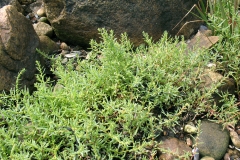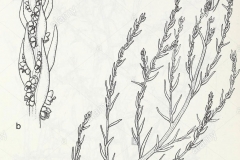Sea Blite has a well-marked taste of salinity, and some notes of earth, being different from all other marine vegetables. It has brilliant performance in warm dishes (eggs, mushrooms), hot dishes (fish and seafood) and possibly pickles. It is gathered from the wild for local use as a food and source of materials. Sea Blite is rich in protein, fiber, vitamin B6, vitamin E and chromium. It is a source of manganese and contains lutein, phenols, flavonoids and tannins.
Sea Blite Facts
| Sea Blite Quick Facts | |
|---|---|
| Name: | Sea Blite |
| Scientific Name: | Suaeda maritima |
| Origin | Virginia north into eastern Canada |
| Colors | Reddish-brown or black (Seed) |
| Shapes | Monomorphic, lenticular, 1–2.2 mm diameter (Seed) |
| Name | Sea Blite |
|---|---|
| Scientific Name | Suaeda maritima |
| Native | Virginia north into eastern Canada but also two western counties in Florida, a county in the middle of Kentucky, one northern county in Washington, southern Alaska, and Manitoba |
| Common Names | Sea Blite, Herbaceous seepweed, Rich’s seepweed, Annual Sea-Blite, Seaside Indian Saltwort |
| Name in Other Languages | Afrikaans: Seablite Albanian: Seablite, minurth Amharic: Baḥirī (ባሕሪ) Arabic: Seablite, suayda’ bahria (سويداء بحرية) Armenian: Tsovap (ծովափ) Azerbaijani: Seablite Bengali: Seablite Bulgarian: Seablite, морска суеда, Burmese: Painlaal raytanhkwan (ပင်လယ်ရေတံခွန်) Catalan: Salat maritime, Canyametes Chinese: Seablite, Luǒ huā jiǎn péng (裸花鹼蓬) Croatian: Seablite, primorska jurčica Czech: Mořský vlk, solnička rozprostřená, Solnička přímořská Danish: Strandgasefod, seablite, Almindelig strandgåsefod , Strandgåsefod Dutch: Klein schorrenkruid, zeeblind, Schorrenkruid, Klein schorrekruid English: Annual sea-blite, Herbaceous seepweed, Sea blite, Common Seablite, Sea blite, White sea-blite, salt goosefoot, Atlantic sea-blite, Herbaceous Seablite Esperanto: Sidloko Estonian: Merelinnak, rand-soodahein Filipino: Seablite Finnish: Seablite, Pikkukilokki French: Soude maritime, Sueda maritime, seablite, blanchette, suéda en épis Georgian: Zghvisp’iri (ზღვისპირი) German: Indisches Salzkraut, Strandsode, Strand-Sode, Seablite, Strandsalzmelde, Meerstrand-Gänsefüßchen, Schmalzmelde, Sode, Greek: Thalassopoúli (θαλασσοπούλι) Guajarati: Sīblā iṭa (સીબ્લાઇટ), Mōraḍa (vanaspati),(મોરડ (વનસ્પતિ)), lano (લાણો), morad (મોરડ), moras (મોરસ) Hausa: Seablite Hebrew: Ym (ים) Hindi: Alur, seablite Hungarian: Seablite, heverő sóballa, magyar sóballa Icelandic: Sjóblástur, salturt, Salturt, saltjurt Indonesian: Seablite Irish: Seablite, blide mhara Italian: Seablite, suaeda, suaeda marittima Japanese: Shīburaito (シーブライト), Hama matsuna (ハママツナ) Javanese: Segawon Kannada: Sīblaiṭ (ಸೀಬ್ಲೈಟ್) Kazakh: Teñiz qabatı (теңіз қабаты) Korean: Seablite, hae hong na mul (해홍나물) Kurdish: Seablite Lao: Phun thale (ພື້ນທະເລ) Latin: Seablite Latvian: Jūras dzelme, Jūrmalas sveda Lithuanian: Jūros dugnas, Pajūrinė soduotė Macedonian: Morska voda (морска вода) Malagasy: Seablite Malay: Seablite Malayalam: Kaṭalttīraṁ (കടൽത്തീരം) Maltese: Seablite Marathi: Seebalait (सीबलाइट), moras (मोरस) Mongolian: Dalain urgamal (далайн ургамал) Nepali: Siblā iṭa (सिब्लाइट) Northern Sami: Sálteurttas Norwegian: Seablite, Saftmelde, Strand-melde Oriya: ସମୁଦ୍ର, ଗେଡ଼ିଆ gerdia Pashto: سیبلایټ Persian: ساحل, سیاهشور دریایی Polish: Seablite, Sodówka nadmorska Portuguese: Seablite, Valverde-da-praia Punjabi: Samudarī pāṇī (ਸਮੁੰਦਰੀ ਪਾਣੀ) Romanian: Seablite Russian: Seablite, Sveda primorskaya (Сведа приморская) Scottish Gaelic: Blide mhara Serbian: Morska trava (морска трава) Sindhi: سامونڊي ڪناري Sinhala: Muhudu patla (මුහුදු පත්ල), Umunddi, umiri Slovene: Primorski slanorad Slovenian: Morska moka Spanish: Seablite, almajo, babosa, cañametes, espejuelo, marroquines, matilla, salitrera, sosa blanca, sosa negra, Slanorad primorski Sudanese: Leablite Swedish: Seablite, Pikkukilokki, Saltört Tajik: Seablite Tamil: Koyey kasseray keeray, Kayey kaseeray keray, Yella keeray, Cīplaiṭ (சீப்லைட்), Nila Vumarai, nir-umari (நீருமரி), Umarikkīrai (உமரிக்கீரை) Telugu: Kodee kasseray kura, Kodee kasseery kura, Vellakora, Yella kura, seablite, Alagu Thai: Cha khraam (ชะคราม), seablite Turkish: Seablite Ukrainian: Morsʹka klitka (морська клітка), sodnyk prostertyy (содник простертий) Urdu: سمندری غذا Uzbek: Dengiz sebliti Vietnamese: Muoi bien, đá biển, Phì diệp biển Welsh: Seablite, Gŵydd-Droed Arfor, Helys Unflwydd, Troed yr Ŵydd Arfor Zulu: Seablite |
| Plant Growth Habit | Robust, perennial, polymorphous, glabrous, much branched, succulent annual herb |
| Growing Climates | Salt marshes and sea shores |
| Soil | On moist, saline, clayey soils near the sea |
| Plant Size | About 20-50 cm in height, reaching out to 2 m in diameter |
| Stem | Prostrate, decumbent, or erect, usually light brown, simple or branched, sometimes slightly woody at base; main branches arising from proximal part of plant |
| Leaf | Simple and arranged alternatively, with one leaf per node along the stem. Their leaves also absorb large amounts of salt and will turn red when oversaturated |
| Flowering season | July to October |
| Flower | Flower can be either radially symmetrical or bilaterally symmetrical. Flowers 1-3 together in axils of upper leaves, each with 5 green triangular sepals, no petals, and 5 pale yellow stamens |
| Seed | Monomorphic, lenticular, 1–2.2 mm diam.; seed-coat reddish-brown or black, reticulate |
| Propagation | By Seed |
| Season | August to October |
| Other Facts |
|
Plant Description
Sea Blite is a robust, perennial, polymorphous, glabrous, much branched, succulent annual herb that normally grows to 20-50 cm in height, reaching out to 2 m in diameter as an upright or spreading shrub. The plant is found growing on seashores, in saltmarsh, mud, sand, sometimes below tideline. It makes an attractive edible feature bush in a succulent garden, rockery or side garden bed. It is found on moist, saline, clayey soils near the sea. Stem is prostrate, decumbent, or erect, usually light brown, simple or branched, sometimes slightly woody at base; main branches arising from proximal part of plant.
Leaves
Leaves are fleshy, semi-cylindrical, and simple and arranged alternatively, with one leaf per node along the stem. Leaves blades are linear, usually sub-terete, sometimes flat, 10–50 mm long and 0.8–1.7 mm wide, apex blunt to acute. Leaves also absorb large amounts of salt and will turn red when oversaturated.
Flowers
The flower can be either radially symmetrical or bilaterally symmetrical. Flowers are tiny, 1-2 mm in diameter. Flowers occurs 1-3 together in axils of upper leaves, each with 5 green triangular sepals, no petals, and 5 pale yellow stamens. Flowering normally takes place in between July to October.
Seeds
Seeds are monomorphic, lenticular, 1–2.2 mm diameter. Seed-coat is reddish-brown or black and reticulate.
The life cycle of Suaeda maritima is known to be mainly annually. The plant will perform its entire life cycle from seed to flower then back to a seed within a single growing season. All roots, stems and leaves of the Suaeda maritima plant will die and the only thing that can bridge the gap between each generation is a dormant seed.
Culinary Uses
- Young leaves can be consumed raw or cooked.
- It has a pleasant salty flavor; they make a nice addition in small quantities to a salad.
- They are often mixed with other vegetables in order to reduce their saltiness.
- The young shoots are pickled in vinegar and eaten on their own or used as a relish.
- Seed can be consumed raw or cooked.
- Local people in Samut Songkram province use sea blite for different types of cooking such as traditional sea blite salad, sea blite curry with crabs, or scalded sea blite with chili paste.
- In the South of India, sea blite is pickled in vinegar or used for cooking as well as domestic animal food.
References:
https://www.itis.gov/servlet/SingleRpt/SingleRpt?search_topic=TSN&search_value=20662#null
https://npgsweb.ars-grin.gov/gringlobal/taxon/taxonomydetail?id=486847
https://pfaf.org/user/Plant.aspx?LatinName=Suaeda+maritima
https://www.cabi.org/isc/datasheet/117385
https://botanical.com/botanical/mgmh/b/bliase57.html
http://luirig.altervista.org/schedenam/fnam.php?taxon=Suaeda+maritima+ssp.+maritima
http://www.theplantlist.org/tpl1.1/record/kew-2484020
https://inaturalist.ala.org.au/taxa/169432-Suaeda-maritima
https://indiabiodiversity.org/species/show/266351
https://www.flowersofindia.net/catalog/slides/Annual%20Sea-Blite.html
https://plants.jstor.org/compilation/Suaeda.maritima
https://en.wikipedia.org/wiki/Suaeda_maritima
https://gd.eppo.int/taxon/SUEMA
http://www.naturalmedicinalherbs.net/herbs/s/suaeda-maritima=sea-blite.php
https://plants.usda.gov/home/plantProfile?symbol=SUMA


